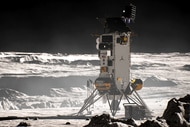NASA renames new space telescope after pioneering astronomer Nancy Grace Roman

What was once called the Wide Field Infrared Survey Telescope (WFIRST) will now be named the Nancy Grace Roman Space Telescope, and I am very pleased about this.
The Roman Space Telescope (or RST) will be a game-changer: It's the same size as Hubble Space Telescope, with a 2.4-meter (8-foot) mirror, but designed to do very different astronomy. One of its instruments is a wide-field camera with 100 times the field of view of Hubble (!!), and the other is designed specifically to take direct images of planets orbiting nearby stars. It will be able to see light from visible wavelengths (what our eyes see) out to 2 microns (more than three times redder than our eyes can detect) in the infrared. This makes it a fantastic complement to the James Webb Space Telescope, which also sees in the infrared, but won't have nearly this wide a grasp of the sky.
I'll get back to the science in a sec, but I want to make sure you understand how wonderful it is that they've named after Nancy Grace Roman.
Roman was an absolute pioneer in modern astronomy. She had a lifelong love of the stars, beginning when she was a child. She got her PhD from the University of Chicago (a top school in astrophysics) in 1949. Think on that for a moment, what society was like at that time, especially for women. She had to fight the environment of sexism from top to bottom, constantly having hurdles thrown in front of her, but she overcame them to become a crucial figure in astronomy history.
She knew getting tenure as a woman would be extremely difficult, so instead she worked first for NRL and then applied to work at the newly formed NASA, where she became the Head of Observational astronomy in early 1959. While there she pushed hard for launching telescopes into space, eventually leading the Orbiting Astronomical Observatory program, which sent four telescopes into space (two failed — this was brand new engineering back then) and were the precursors of the amazing observatories we have in space now.
She's sometimes called the mother of Hubble Space Telescope, because she promoted the idea in the 1960s (!) and was foundational in getting the program started. It's safe to say that without her, Hubble as we know it now would never have existed.
She continued to be active in promoting astronomy and science, especially to girls, right up to the end of her life in 2018. She was an inspiring figure, and renaming WFIRST after her is perfect. I'm really happy NASA did this.
Despite the many, many women who have contributed to astronomy, very few telescopes and observatories are named after them. Recently, the Large Synoptic Survey Telescope was named after astronomer Vera Rubin, which was a great decision, and there are a handful (but only a handful) of others. To my knowledge this is the first space-based telescope named after a woman. So good on ya, NASA.
I'll note that when it was still WFIRST, it had a rocky road. Trump's NASA budget request canceled it, twice, once for the 2019 budget and again for 2020, but both times Congress put it back in. It's unclear why the White House wanted to kill it (at one point the budget notes said "[it] would have required a significant funding increase in 2019 and future years…" which is forehead-slappingly silly; of course it would. That's how early budgeting works. You spend some money at first to develop a project, then more later as it matures. The project was downsized somewhat during this process, but the capabilities it will have are staggering.
The Wide Field Instrument will have the same resolution (ability to see small structures) as Hubble, but will have a stunning 100 times the field of view, meaning in the same time Hubble could see a small patch of the sky, RST will see a much, much larger patch (the S in WFIRST was for Survey, meaning it's designed to look at huge swaths of the sky at a time). This camera will be used to look at large scale structure in the Universe to get a better understanding of dark matter and dark energy, survey large objects (like the Andromeda Galaxy, which is ten times the width of the full Moon on the sky), and look for planets orbiting distant stars via gravitational lensing.
The other instrument is a coronograph, which will take direct images of nearby planets. It uses a small piece of metal to block the light from bright stars, to be able to see fainter objects like planets around them. It will also use cutting-edge tech to minimize the leftover scattered light from the stars to really bring out the much dimmer details.
RST will orbit the Sun at the Earth-Sun L2 point, a semi-stable gravitational spot about 1.5 million kilometers away from Earth in a direction opposite the Sun. Launch is planned for the mid-2020s, and work has already begun in designing and building the observatory's components. The total cost should be roughly $4 billion, which includes the first five years of operational costs.
I am very much looking forward to seeing what this 'scope will do. The astronomy it will bring us will be stunning, and I'll have fun writing about it. And I am very much looking forward to calling it the Roman Space Telescope when I do.






























